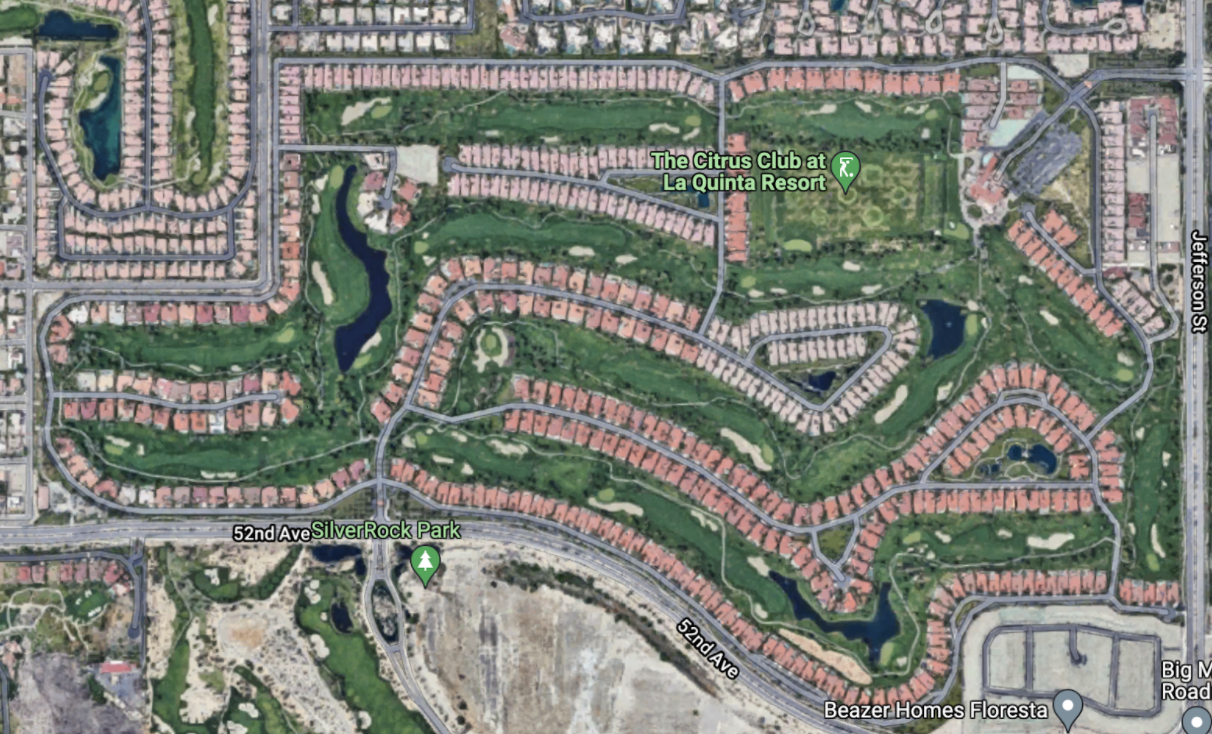Index
Open Links Housing Index
At Open Links, we try to make it easy for passionate golfers to find courses based on attributes that are important to them. We’ve heard feedback from our advisory users’ group while building the product that playing a course with no housing or commercial development enhances the overall experience. On the flip side, playing a course where houses line the holes takes away from the serenity and peacefulness of the surroundings and makes the game slower and more difficult. When housing is present, there are longer distances between holes and more out of bounds in play around the course.
This feedback led us to create a data field on our free website that looks at the amount of housing and development on and around each golf course. We established what we are calling the Housing Index by looking at satellite images for each of the 4,000+ courses in our US database and grouped courses into four categories based on how much housing and development was present.
From a high level, housing indices appeared as follows. A course with
-
A very low housing index has no housing on the interior or housing/development on the exterior of the golf course.
-
A low index has no housing on the interior but has development along the exterior.
-
A medium index has housing on the interior of the golf course along some holes (but not all).
-
A course with a high index has housing on the interior along the majority of holes and, in many cases, housing on both sides of many holes.
If you’d like to learn more about the Housing Index category definitions and see some example images, please scroll to the bottom of this write-up.
In December 2021, we collected and analyzed the housing index data and wanted to share our findings. Across all of the courses in our U.S. database at the time of the study, 14% had a very low index, 56% had a low, 21% had a medium, and 9% had a high index.
Throughout this write-up, we will combine the medium and high indices and refer to this combination as Housing Percentage, since there is housing on the interior of the medium and high housing index golf courses. When using this combination, roughly 30% of courses in our US database have housing on the course, and 30% do not (i.e., very low and low indices). Before we dig more into the current state of housing on golf courses, let’s look at what has happened in the past.
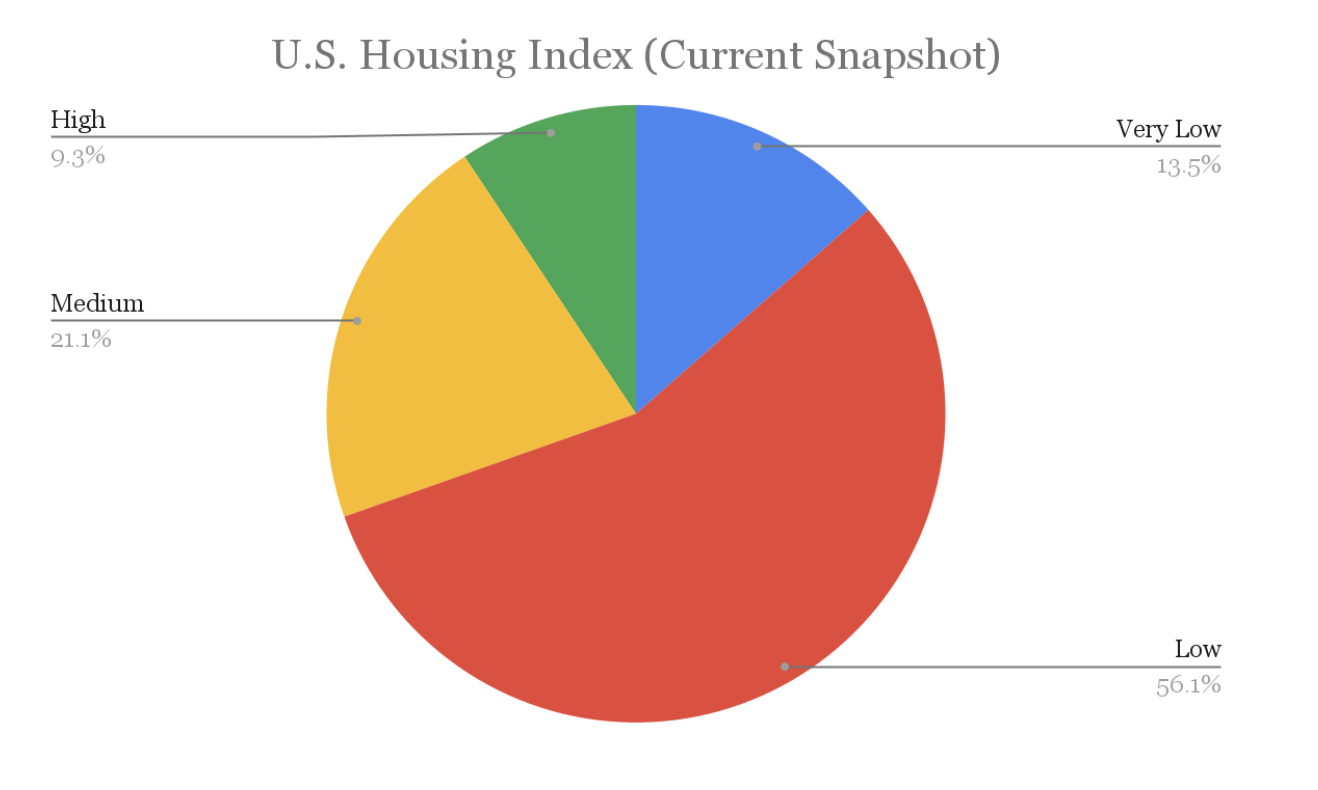
History
Housing was not common in the early days of U.S. golf course construction, with less than 10% of courses having housing (i.e., medium or high index) in each decade from 1900 to 1940. It was not until the 1950s that there was a spike in courses built with housing. This increased over the 1960s and 1970s to a peak in the 1980s (see charts below). The trend reversed course in the 1990s and has continued to decrease into the 21st century.
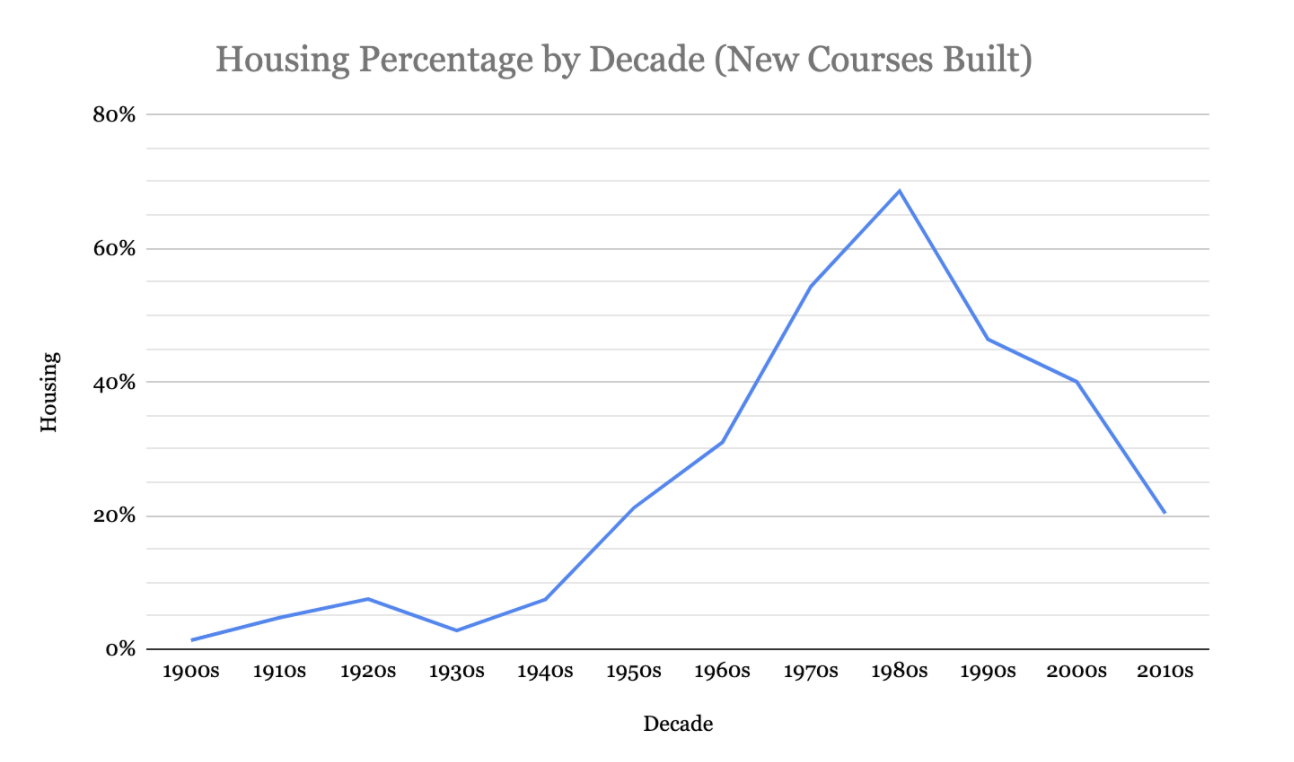
There are some interesting trends in the individual Housing Index classifications as well. Following the rise in popularity of “destination” resorts and clubs, courses with a very low housing index are now the second most popular type of course being built. On the other hand, courses with a high index now rank at the bottom, representing only 5% of new courses built in the 2010s. Real estate and golf will always go hand in hand to some extent. However, we believe the days of developers building houses along each hole are likely a thing of the past, to the joy of the golf purists out there.
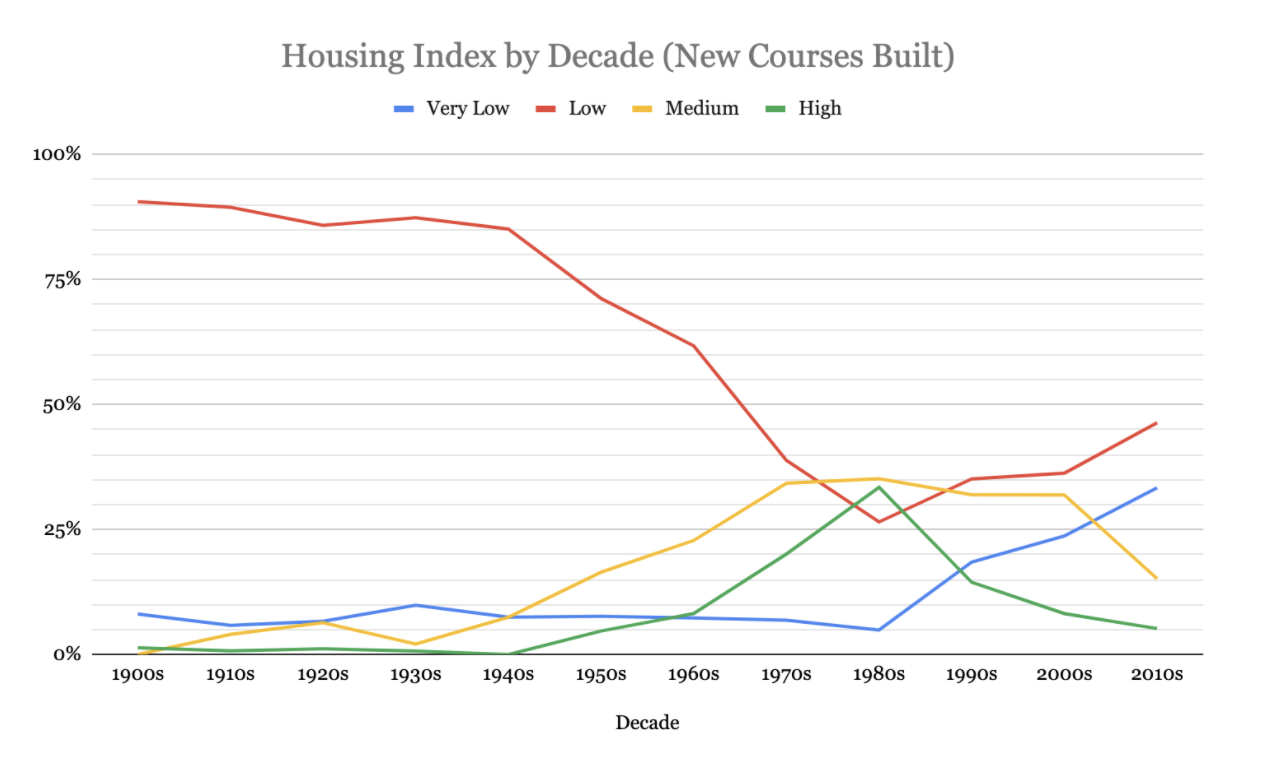
Type
We categorize the courses in our database into five types based on ownership and accessibility: Muni, Public, Resort, Semi-Private, and Private. Munis, which are open to all players at any time and owned by a city, town, county, or state, had by far the lowest percentage of housing, at only 6%. Resorts and Semi-Private were tied with the highest percentage, at 40%. Those looking for a course void of housing can likely count on their local muni coming through and providing that experience.
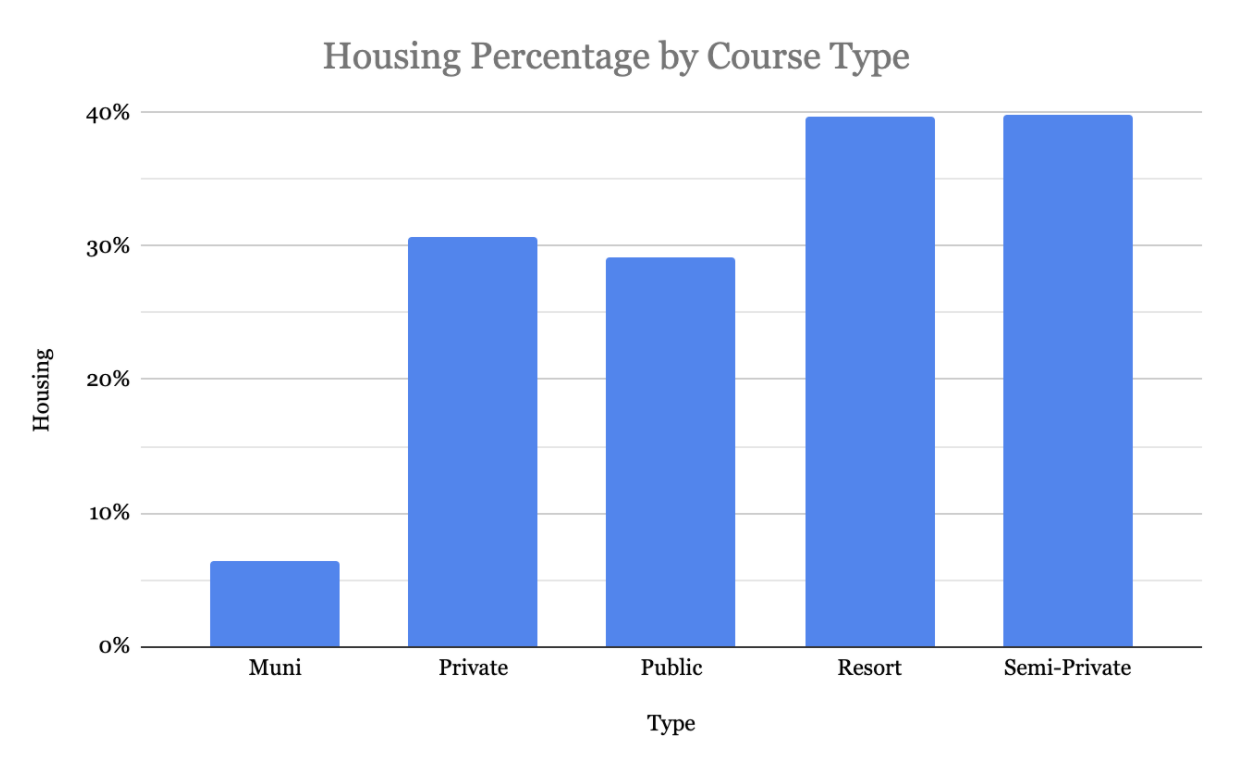
When looking at the individual housing index classifications, we found that Munis were also the only course type not to have any courses with a high housing index. Resorts had the highest percentage of very low housing index courses, driven by the rise in popularity of resorts like Bandon Dunes and Streamsong that pride themselves on providing their guests with a “pure golf” experience. Private courses had the lowest percentage of a very low housing index. Many were built in neighborhoods and close to population centers, making it difficult to have the seclusion and buffer necessary to be classified in the very low category.
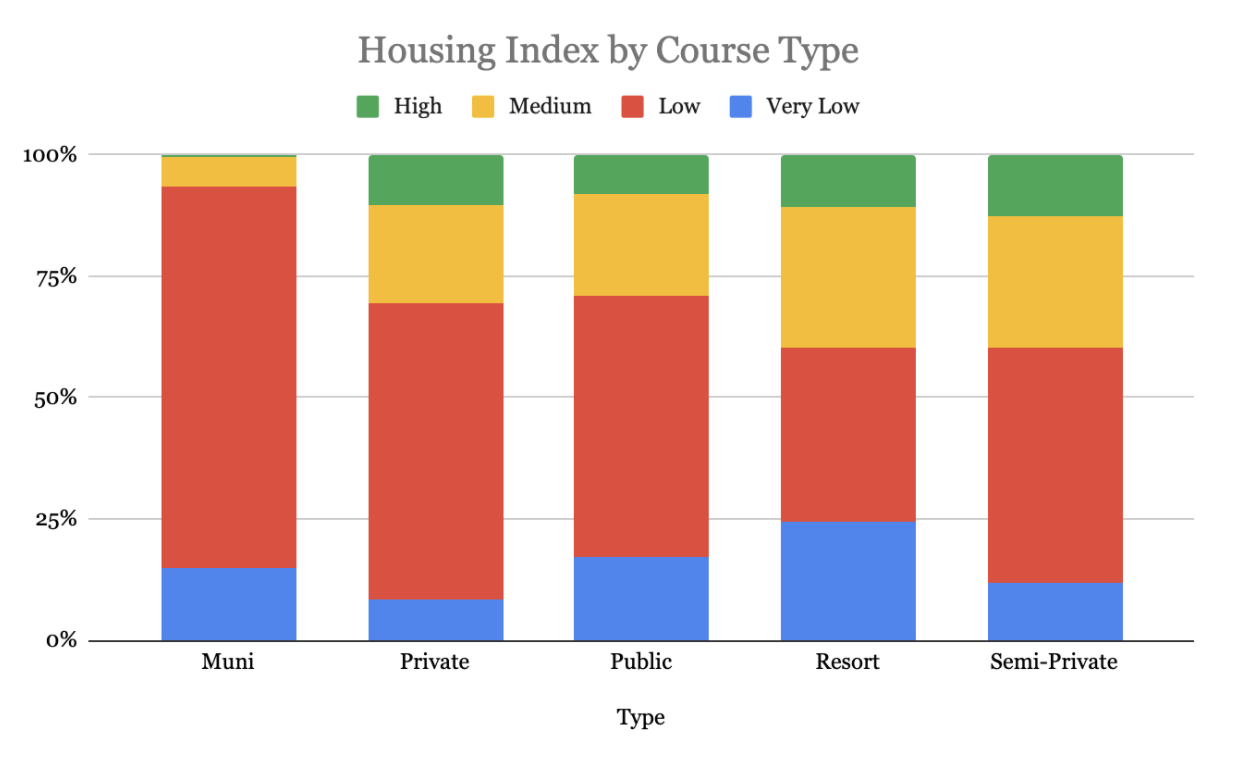
There were also significant differences in the Housing Indexes of 9-hole courses compared to 18-hole courses, the former being much less likely to have housing on the golf course. Real estate developers likely believe that having an 18-hole course is more of a selling point than a 9-hole course, as well. New England (and states like Maine and Rhode Island) have more 9-hole courses, which likely helped decrease their overall housing percentage, as we’ll cover in the next section when we review housing by region and state.
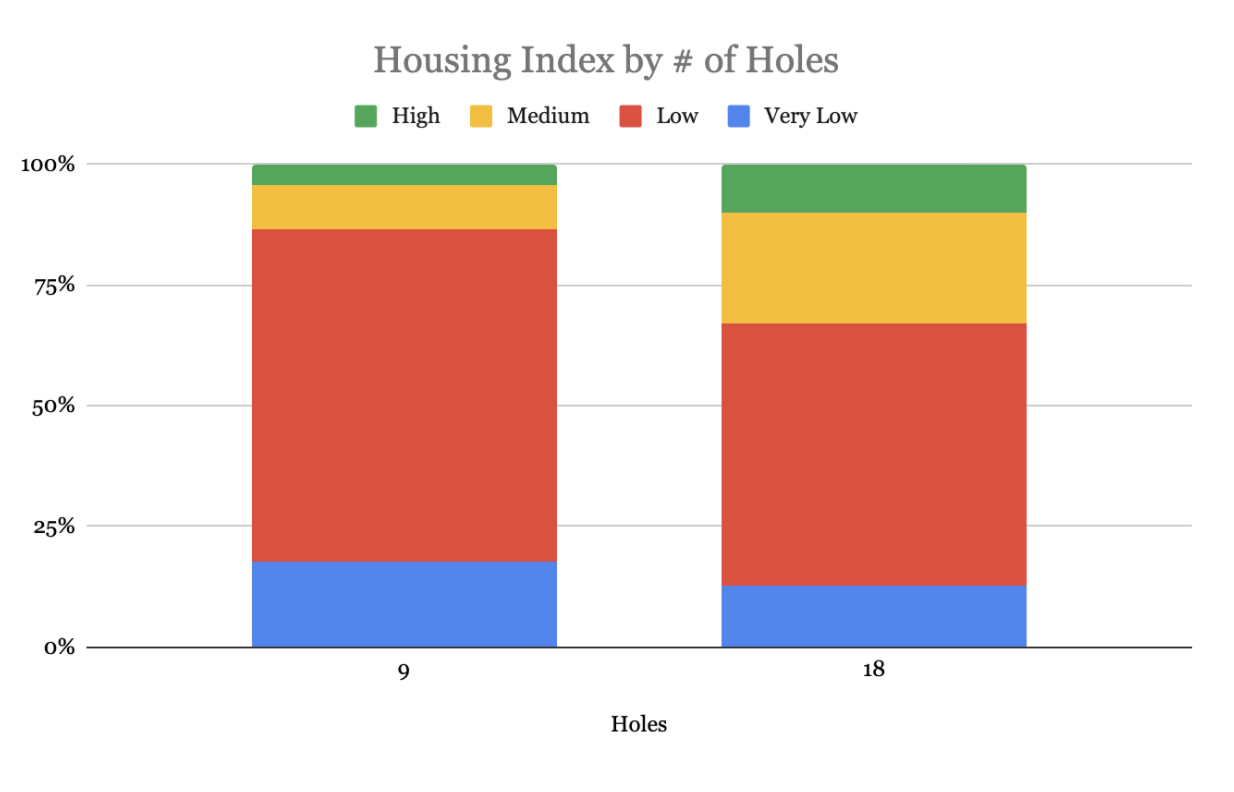
Location
For our regional analysis, we used the U.S. Bureau of Economic Analysis regions:
-
Great Lakes (IL, IN, MI, MN, OH, WI)
-
Mid-Atlantic (DE, DC, MD, PA, VA, WV)
-
New England (ME, MA, NH, RI, VT)
-
Pacific Northwest (AK, WA, OR)
-
Plains (IA, KS, MO, NE, ND, SD)
-
Rocky Mountain (CO, ID, MT, UT, WY)
-
Southeast (AL, AR, FL, GA, KY, LA, MS, NC, SC, TN)
-
Southwest (NM, OK, TX)
-
Tri-State (CT, NJ, NY)
-
Western-Pacific (AZ, CA, HI, NV)
The regions with the lowest housing percentage were Tri-State (8%), New England (10%), Great Lakes (18%), and Mid-Atlantic (20%). The regions with the highest percentage were the Southeast, Western-Pacific, and Rocky Mountain, all over 45%.
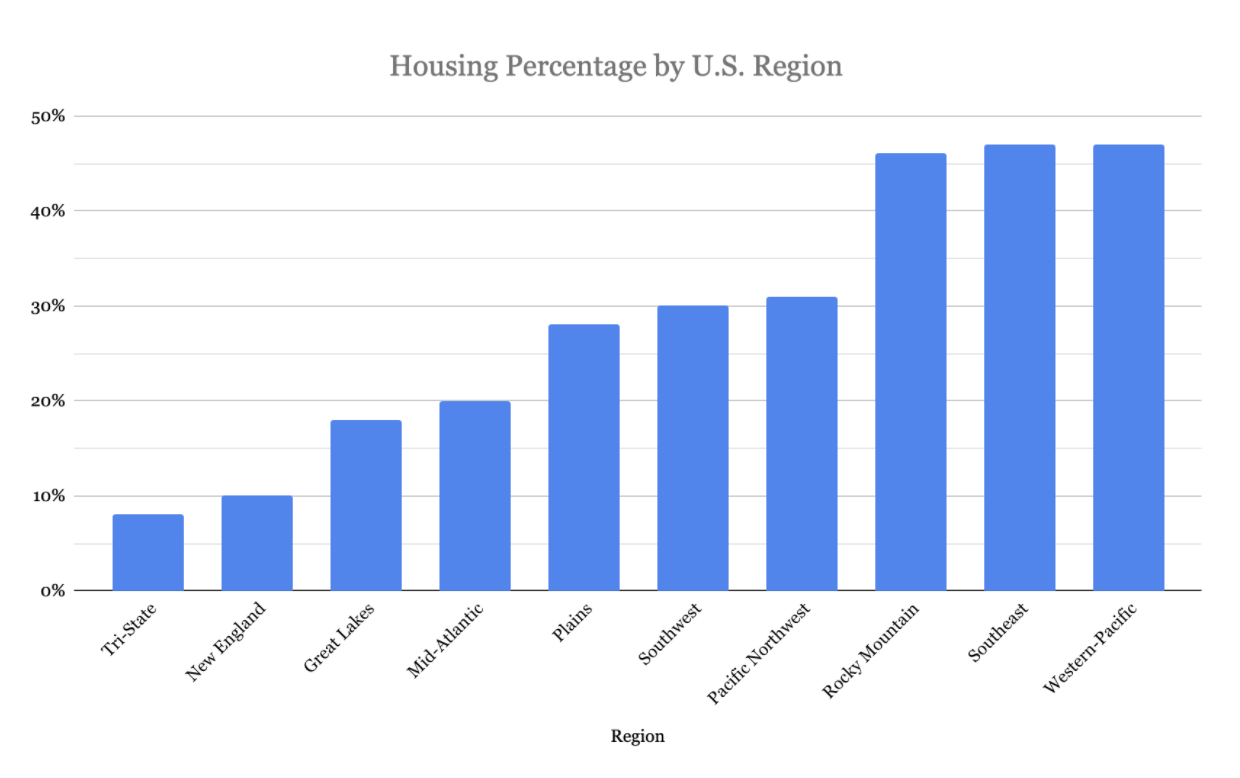
Our data shows:
-
The Southeast and Western-Pacific had the highest High index (17%), followed by the Southwest (14%).
-
The Pacific Northwest had the highest Very Low index (24%), followed by New England (22%).
-
The Pacific Northwest Very Low index has been driven by “destination” resorts built in the past 30 years (e.g., Bandon Dunes, Silvies Valley Ranch, Gamble Sands).
-
New England’s Very Low index is a mixture of public and private courses built in the Modern (post-1960) and Classic (pre-1960) eras.
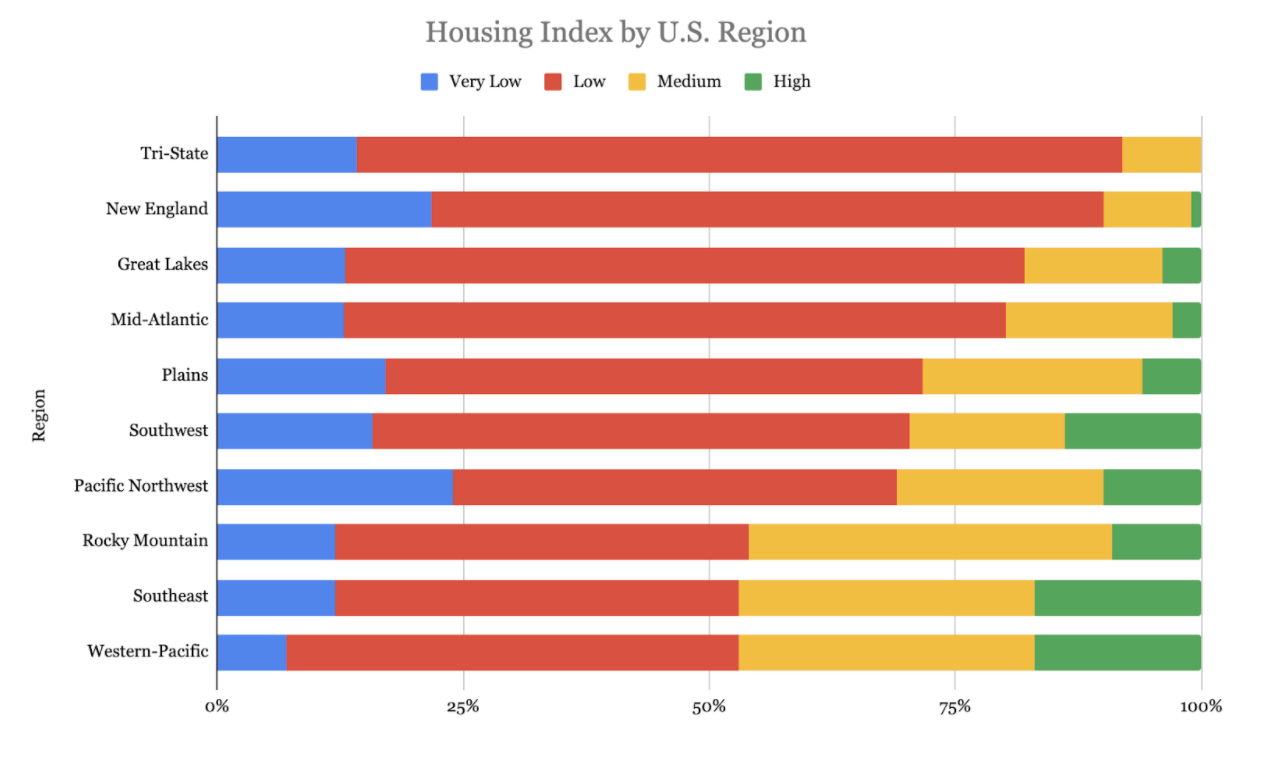
As mentioned earlier, the spike in courses with housing started in the 1950s, roughly the same time many of the golf courses in the regions with high housing percentages were built. For a more apples-to-apples comparison, we looked at the regions with the highest housing percentages and how they’ve changed as the overall housing percentage has decreased since their peak in the 1970s and 1980s.
Of the regions with the highest housing percentage, the Pacific Northwest and the Southwest have dropped the most over time, with less than 10% of the courses built in the last decade (the 2010s) having housing. The Rocky Mountain region, on the other hand, has been the slowest to decrease its percentage over time. A hypothesis is that as regions experience a population increase, the housing percentage will increase relative to other regions that are not experiencing growth.
Many of the Rocky Mountain regions (CO, ID, UT) are amongst the fastest-growing states in the U.S. The Rocky Mountain region has also experienced a growth of “active lifestyle” private clubs and resorts, many of which offer activities that are prioritized as much as golf when land planning.
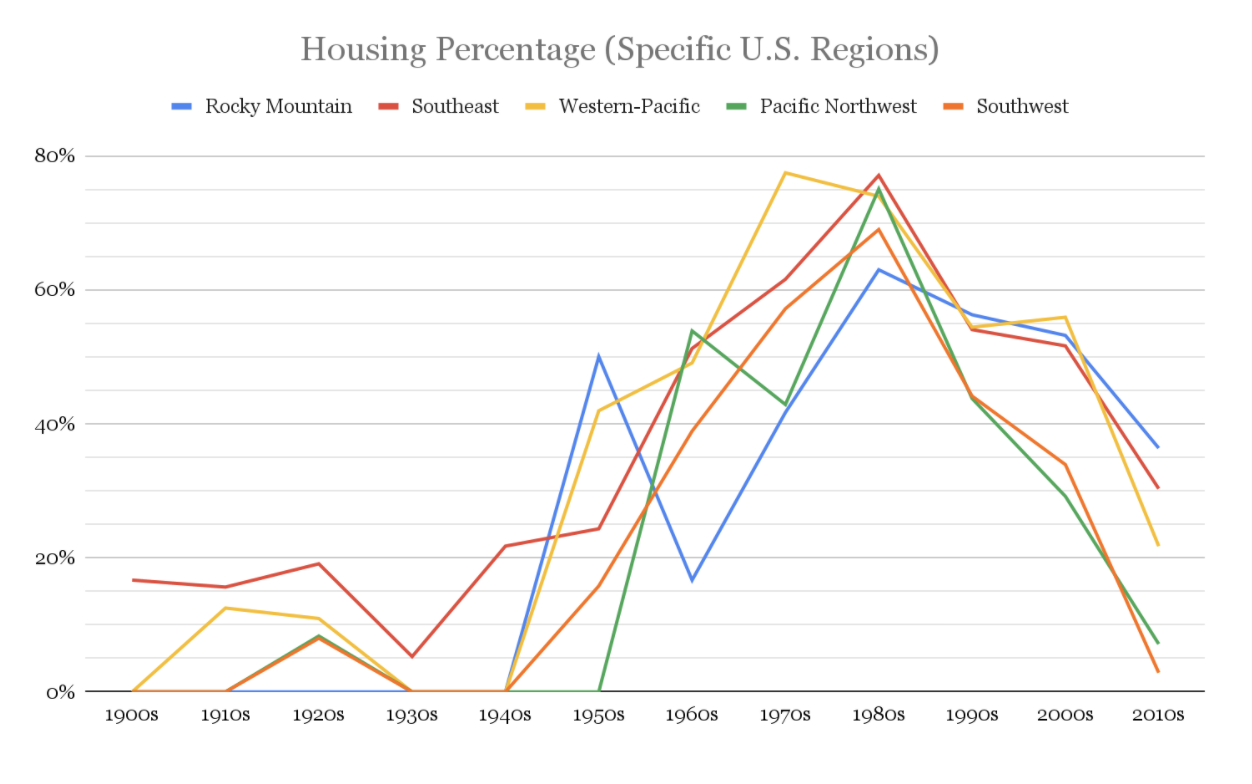
Of the states with more than 20 courses in our database, Rhode Island and Pennsylvania had the lowest housing percentage (7.7%), followed by Maine and Connecticut (7.9%). Arizona came in with the highest housing percentage (67%), followed by Arkansas (56%) and Nevada (56%). North Carolina, South Carolina, Florida, Hawaii, and Utah were the other states with a housing percentage above 50%.
When looking at the individual housing index classifications, Nevada had the highest high index (29%), followed by Arizona (28%) and Florida (25%). Nebraska had the highest very low index (47%), followed by Vermont (45%) and West Virginia (38%). If you want to travel to a state with no housing or development around the golf course, these three states are your best bet.
It’s interesting to note that the states with the lowest housing percentages were all “cold weather” states and located in the northeast. In contrast, the states with the highest percentages were “warm weather” states located in the south or west. Oklahoma (18%) and New Mexico (19%) had the lowest housing percentage of any “warm weather” state, and Delaware had the highest housing percentage of any “cold weather” state (42%).
We also looked at housing percentage by Metro area. Of the metro areas with more than 20 courses in our database, Southampton on Long Island had the lowest, at zero percent! The top-10 lowest Metro areas were:
-
Southampton (0%) – Note: this represents courses on the eastern end of Long Island
-
Pittsburgh (2.7%)
-
Los Angeles (3.5%)
-
Hempstead (4.2%) – Note: this represents a portion of western Long Island
-
San Francisco (4.6%)
-
Tulsa (5%)
-
Newark (South) (5%) – Note: Newark split in two due to high number of courses
-
Philadelphia (5.3%)
-
Norristown (6.5%) – Note: this represents the northern and western suburbs of Philadelphia
-
Albany (7.1%)
The metro area with the highest housing percentage was Reno, at 80%. The top-10 highest were:
-
Reno (80%)
-
Tucson (74.1%)
-
Naples (71.9%)
-
Aspen (69.6%)
-
La Quinta (67.7%) – Note: this represents the southern section of the Coachella Valley
-
Pinehurst (65.5%)
-
Pensacola (63.6%)
-
Palm Desert (60.7%) – Note: this represents the northern section of the Coachella Valley
-
Jacksonville (60%), Raleigh (60%), Myrtle Beach (60%)
The metro areas with the highest very low indexes were Traverse City (43%), Poughkeepsie (36%), Manchester NH (27%), Boston – North (25%), and Pittsburgh (24%). The metro areas with the highest high indexes were La Quinta (52%), West Palm Beach (41%), Jacksonville (40%), Scottsdale (35%) and Fort Lauderdale (35%).
Architecture
William Flynn and Walter Travis had the lowest housing percentage of the architects with at least 20 courses in our U.S. database, at zero percent! Rounding out the top-10 lowest were William Langford (1.8%), Willie Park, Jr. (2.5%), C.H. Alison (4.1%), Perry Maxwell (6.1%), Tom Bendelow (6.7%), A.W. Tillinghast (7.8%), William Watson (8%), and Donald Ross (8.3%).
Since all architects with the lowest housing percentages were from the Classic (i.e., pre-1960) era, we wanted to point out the Modern (i.e., post-1960) era architects with the lowest percentages. Gil Hanse (9.5%), Tom Doak (11.5%), Bill Coore & Ben Crenshaw (12.9%), and Geoffrey Cornish (17.2%) were all under 20%, and then there was a significant increase, with Rees Jones next lowest at 33.8%.
Of the architects with at least 20 courses in our US database, the duo of Tom Weiskopf and Jay Morrish had the highest housing percentage at 73.9%. Rounding out the top-10 highest were Tom Clark (69.2%), Jack Nicklaus (67.8%), Arnold Palmer (67.5%), Greg Norman (62.5%), Arthur Hills (61.7%), Robert Trent Jones, Jr. (52.2%), Joe Lee (52%), and Ted Robinson, Sr. (52.2%).
The duo of Bill Coore and Ben Crenshaw had the highest very low index at 61.3%, followed by Tom Doak at 57.7%. There were five architects with a high index of over 20%: Tom Weiskopf and Jay Morrish (47.8%), Arnold Palmer (35.1%), Jack Nicklaus (25.7%), Tom Clark (23.1%), and Pete Dye (22.5%).
Below are the Housing Percentages and Housing Indexes of the eleven Architects with 50+ original designs in our U.S. database. These are the most active U.S. architects, so to speak.
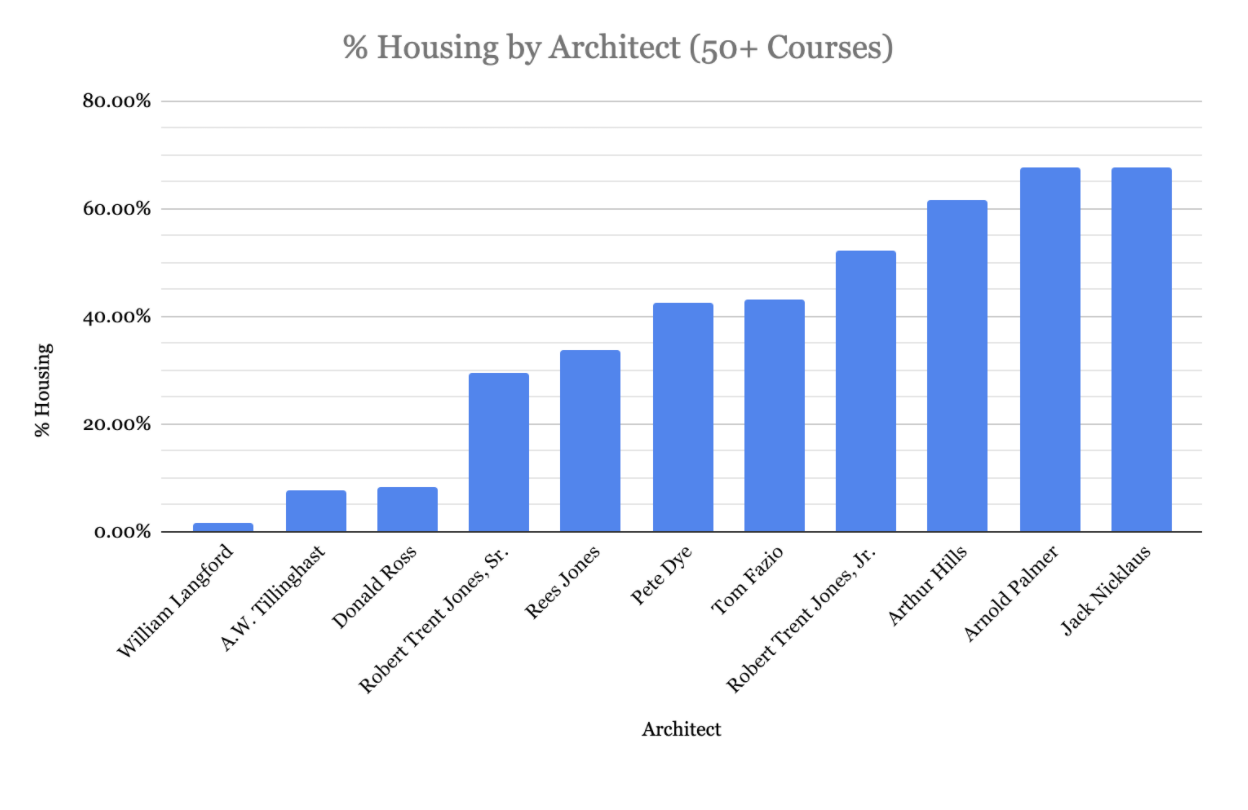
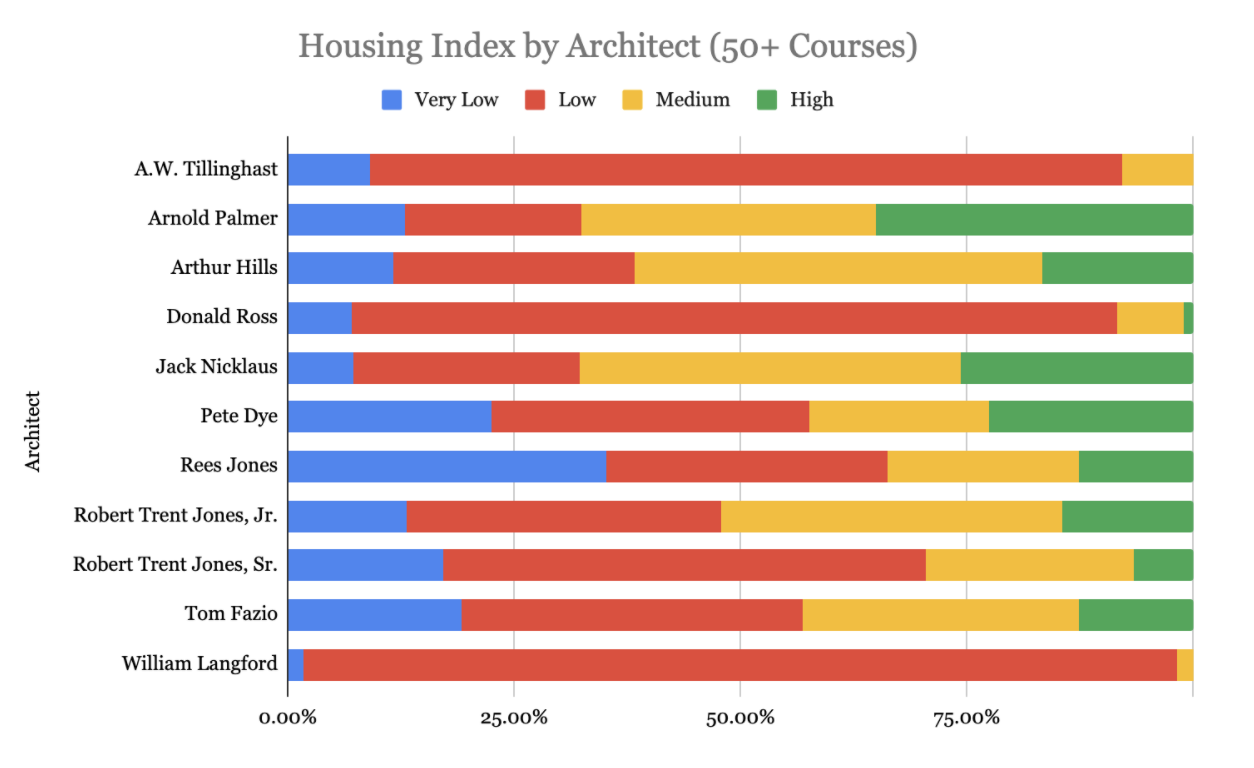
Additional Factors Worth Considering
-
Out of the 426 courses that are ranked nationally by a major U.S. publication (Golf Digest Top 200, Golf Magazine Top 100, and Golfweek Top 200 Classic and Top 200 Modern), only 15% had housing on the course. This is half the average across all golf courses (30%).
-
Regular PGA Tour venues were 3x more likely to have housing than a PGA Major Championship venue.
-
Regular LPGA Tour venues were 2x more likely to have housing than LPGA Major Championship venues.
-
USGA venues were about half as likely to have housing than professional venues.
-
We created Walkability Ratings to help golfers determine how easy (or difficult) it is to walk a course. Only 18% of courses with an easy walkability rating had housing. 70% of courses with a very strenuous walkability rating had housing.
-
We also calculated walking distances via our Walkability Ratings. Courses with housing were on average one-quarter of a mile longer than courses without housing.
Final Thoughts
It’s certainly possible for a course to have housing and still be great. No one will say that Pebble Beach is not a great course because a portion of the golf course intersects with housing. The purpose of our housing index is to provide additional insight into the courses we track and to allow our user base to use this information if it is important to them. For some, an afternoon round at a course with a very low housing index could be a great way to disconnect from the busy outside world for a few hours. Ultimately, it’s all a matter of personal preference.
Open Links Housing Index – Definitions and Examples
Very Low – a course where there is no housing on the interior of the golf course and no housing, commercial development, or major roads on or near the exterior of the golf course. The Dunes course at The Prairie Club in Nebraska (below) is an example of a Very Low Housing Index course.
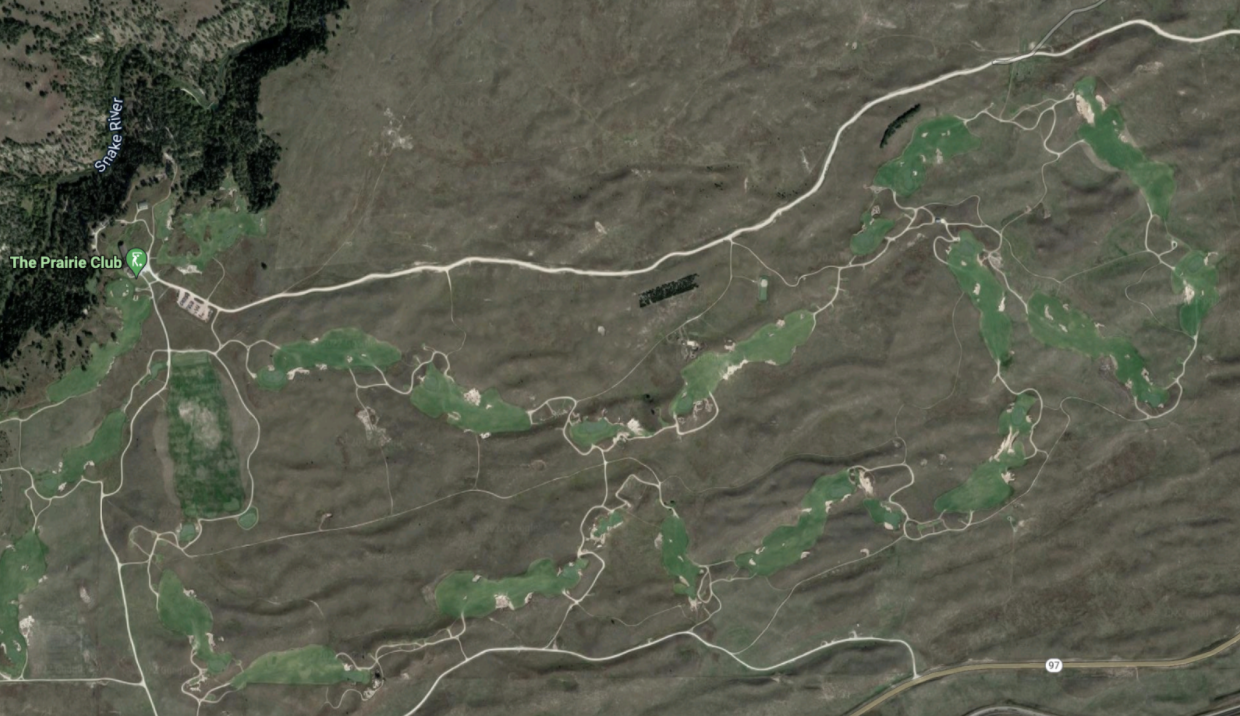
Low – a course where there is no housing on the interior of the golf course; however, there is housing, commercial development, or a major road on or near the exterior of the golf course. There is room between the golf course and the development, but they could be in play and/or in plain sight. Oakmont (below) is an example of a golf course with a Low Housing Index.
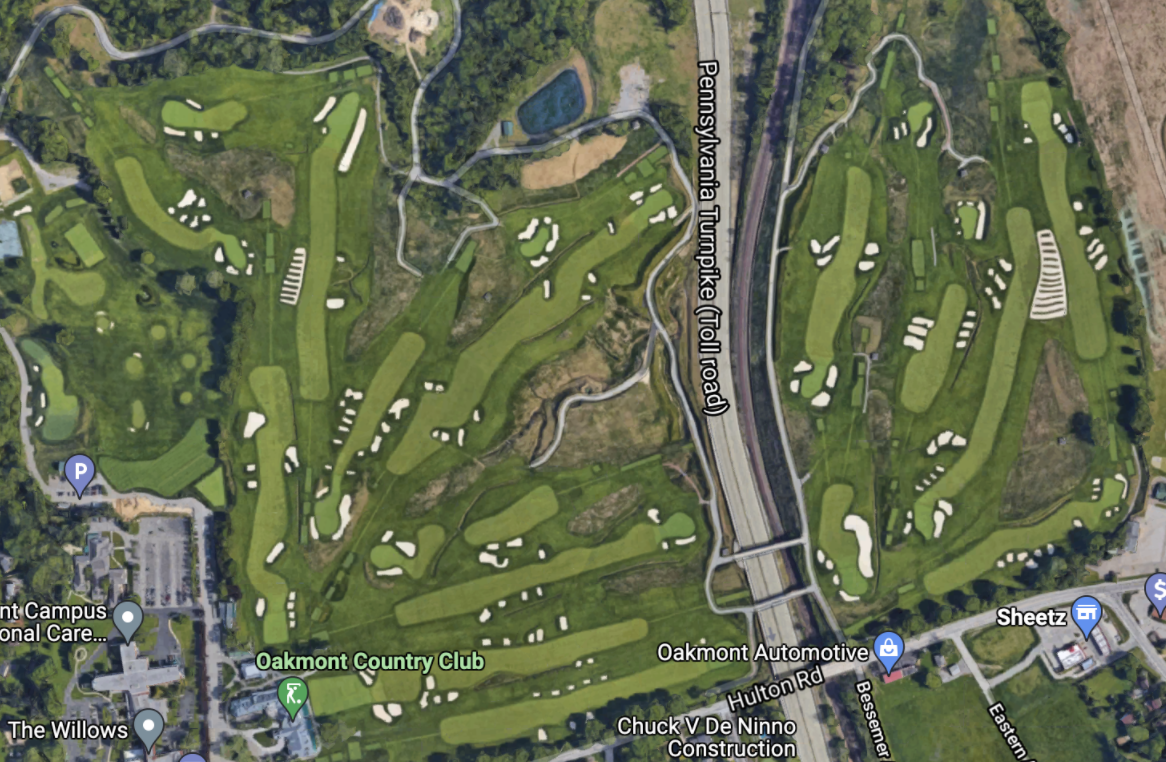
Medium – a course where there is housing on the interior of the golf course (i.e., the course routing intersects with housing), but either there is a stretch of holes where there is no housing, the housing surrounding the holes is low density (e.g., only a few houses along each hole) or the housing is set back from the course and not visible. Muirfield Village (below) is an example of a golf course with a Medium Housing Index.
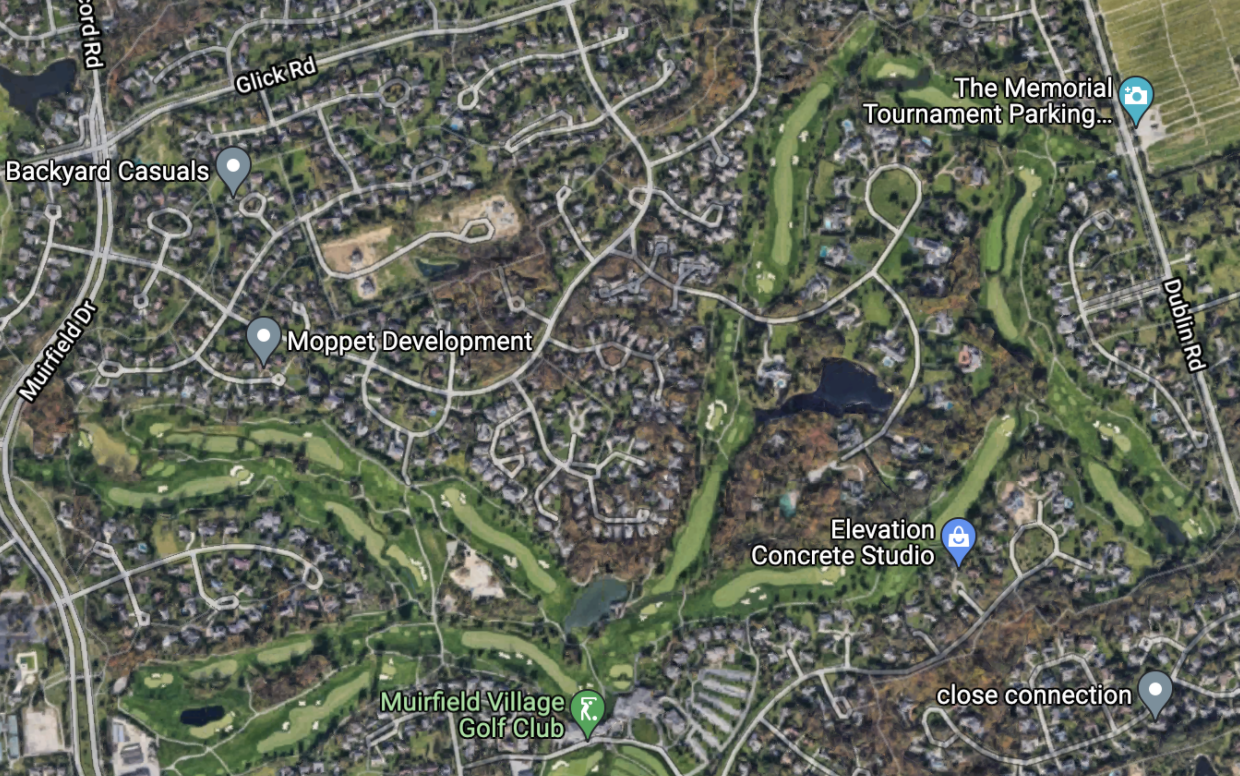
High – a course where there is housing on the interior of the golf course and along the majority of the holes. Housing on both sides of holes is common, with housing being high density and not much room between the housing and the golf holes. A difference between the Medium and High index is the consistency and density of the housing along/within the golf course. The Citrus course at La Quinta Resort (below) is an example of a golf course with a High Housing Index.
